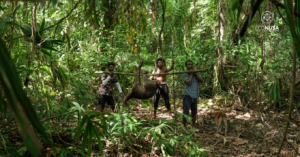
The Indonesian Institute of Sciences (LIPI) reports the research that government should seriously pay attention to the Walking Shark. LIPI jointly with some other organizations found that Walking Shark could possibly undergo evolution process. With the findings, the government needs to get prompt measure to protect unique and endemic species, not only in Indonesia but also in the world.
In Marine and Freshwater Research journal January 21, 2020, entitling “Walking, Swimming, or Hitching A Ride? Phylogenetics and Biogeography of Walking Shark Genus Hemiscyllium”, researchers found that the Walking Shark of Raja Ampat (Hemiscyllium freycineti) and Walking Shark of Halmahera (Hemiscyllium Halmahera) are on differentiation process. Unfortunately, we could hardly observe the evolution results due to the long process.
The finding here uses molecular phylogeny approach. The researchers could estimate the age of evolution and the processes leading to new species. The Walking Shark evolution took place around 9 million years ago. This fact makes the Walking Shark the last evolution species if compared to most of the shark evolution of 200 million years ago.
“We found the change of sea level, formation of new coral reefs, and land play roles for evolution,” said Christine Dudgeom, a researcher from University of Queensland as the leading researcher, as quoted by Kompas.id.
There have so far been nine Walking Sharks in the world. Five of them are in Indonesia and four of them are deemed endemics. Besides, Walking Shark of Raja Ampat islets were found first which was described in 1824. Then, Walking Shark of Cendrawasih Bay (Hemiscyllium Gelei) and Walking Shark of Kaimana (Hemiscyllium Henryi) were described in 2008. Lastly, Walking Shark of Halmahera was described in 2013. Another species, Hemiscyllium trispeculare was found in Aru Island and western Australia continent.
Walking Shark is not like the common sharks. Shark which is deemed the top level predator usually has large body size. But, Walking Shark body is small with less than 1 meter in length. Walking Shark of Halmahera, for instance, has only 70 centimeters long. These animals uniquely use their fins to walk.
Unfortunately, the distinctive animal here is vulnerable to threat. They are easily found when one is doing snorkeling or riding a boat on shallow waters. Excessive fishing is also possibility. Another threat comes from plastic debris, industrial waste and development that violates environmental standards.
The Government of Indonesia protects some kinds of shark species. As from 117 types of shark in Indonesia, only 8 of them is protected, namely: Whale Shark (Rhincodon typus), 3 species of Hammer Shark (S. lewini, S. mokarran, dan S. zygaena), Cowboy Shark (Carcharhinus longimanus), Lanjaman Shark (Carcharhinus falciformis), and 2 species of Mouse Shark (A. pelagicus dan A. superciliosus).
It is necessary for further studies conducted by government in collaboration with many other stakeholders. One of the studies, for instance, is done by identification of population and distribution of Walking Shark, by updating the red status according to the Union for Conservation of Nature (IUCN). In the IUCN website, there is no data on Walking Shark of Kaimana population due to the absence of data.
Ocean Program Manager of EcoNusa Foundation Wiro Wirandi called the government to take necessary measures immediately to protect Walking Shark. As to Wiro, Walking Shark is threatened by excessive and illegal fishing. Without serious attention, it is just a matter of time when Walking Shark is deemed extinct. “The Ministry of Marine and Fisheries has discussed Walking Shark conservation involving many parties. Concrete action is badly needed to protect Walking Shark,” said Wiro.
Editor: Leo Wahyudi




